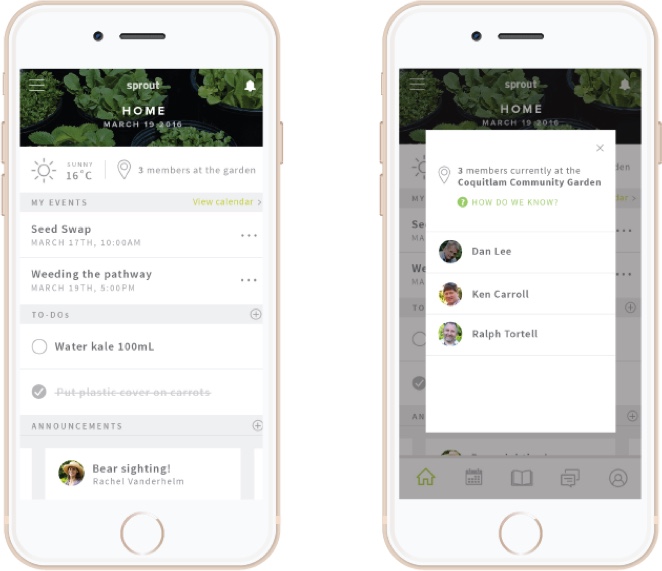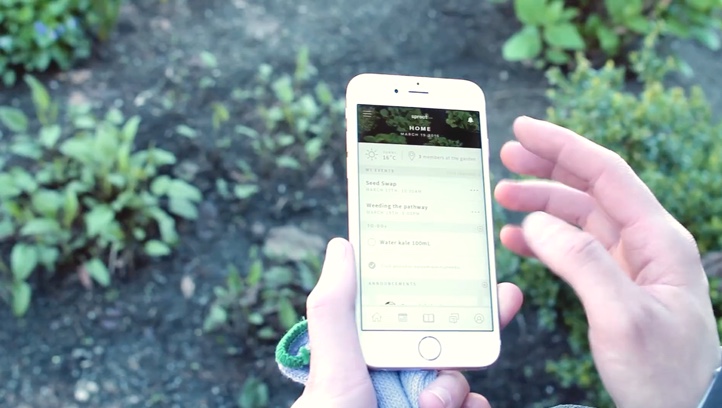Community gardens are meant to be just that - a community. However, when we spoke to members of our local community garden, we learned that these gardens lack that sense of community.
Gardeners enter and exit the garden at different times and rarely meet each other face-to-face.
Our app addresses this problem by giving the gardeners a way to communicate, plan events, and ask each other for gardening advice.
Goals of the gardeners
We reached out to our local community garden and asked its members: Why did you join the garden? What do they hope to get out of the community gardening experience?
 Example screenshots of the user inferface.
Example screenshots of the user inferface.
We learned that there were motivations beyond simply the desire to grow plants. Their three main goals were:
- Meet other gardeners to develop friendships.
- Learn tips and techniques from other gardeners.
- Show off plants that have grown successfully.
 Our visit to the community garden.
Our visit to the community garden.
Goals of the garden coordinator
We asked the garden coordinator, who managed the garden, what issues existed in the community. This is what we learned:
- Poor communication of announcements and upcoming events. The garden had a bulletin board, but members didn’t visit frequently enough to see it and would often miss announcements.
- Unequal contributions to housekeeping tasks. Everyone is expected to do their part to keep the garden in order, but some members weren’t doing as much work as others.
Solving the needs of both
The gardeners wanted to meet each other and make friends. The coordinator wanted the garden to be well-kept and maintained.
Our design challenge: How can we help gardeners meet each other face-to-face, while also helping the coordinator fulfill housekeeping tasks?
We created Sprout, a social media app that encourages members to enter the garden when others are present.
Initial design
In our first prototype, we offered a Tasks section where the coordinator could define housekeeping tasks. Members were then expected to sign up for these tasks at a specific time. Our intention was for members to sign up for tasks that other people had already signed up for so they could show up at the garden at the same time and meet each other.
The Socials section was where members could plan social events unrelated to the upkeep of the garden.
 Tasks were to be predefined by the coordinator. Socials were to be created by gardeners.
Tasks were to be predefined by the coordinator. Socials were to be created by gardeners.
Main design issues
Through user testing our prototype, we uncovered two issues:
Confusion between Tasks and Socials. Users didn’t understand the difference between them, and question why they were seperated in the first place since they functioned the same way.
Just an event planning app? At this point, our app was nothing more than an event-planning app, making it a weak alternative to other services such as Facebook. We had overlooked other possible ways to improve communication and relationships between gardeners.
Revising the app
Based on user testing feedback, these were the changes we made:
Combine Tasks and Socials. We got rid of these categories completely and put them under one name: Events.
Predefined event suggestions. We still wanted a way for the coordinator to encourage her gardeners to do housekeeping tasks. So, our event-creation process includes a screen that makes event suggestions. These suggestions are defined by the coordinator and include the housekeeping tasks she wants to get done.
 When creating a new event, users can choose from a list of suggestions (housekeeping tasks defined by the coordinator), or they can choose to create a custom event of their own.
When creating a new event, users can choose from a list of suggestions (housekeeping tasks defined by the coordinator), or they can choose to create a custom event of their own.
Look beyond event planning and focus on building friendships. We added an Advice Board, which lets users post and answer questions about their plants.
 The Advice Board lets members share gardening advice with each other.
The Advice Board lets members share gardening advice with each other.
Our biggest improvement was to look beyond just event planning and focus on fostering friendships.
We also added a Live Counter to the home screen. One barrier to meeting people in the garden was never knowing what times other people were there; sometimes gardeners would stop by the garden hoping to run into someone, but no one would be there. The Live Counter uses geofencing to display how many people are at the garden, at all times. This way, gardeners hoping to make friends can be sure that they are going to bump into someone. This creates more chances for face-to-face interactions and friendship-building.
 The Live Counter shows how many people are at the garden, at all times.
The Live Counter shows how many people are at the garden, at all times.
